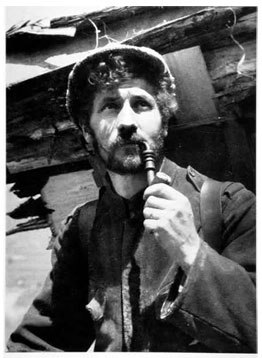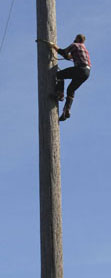
Priol relaxes with his favorite pipe
outside of his log cabin/control room..
To look into the night sky is to look into the past. And that is just what amateur radio astronomer Olaf Priol has done with his home-built radio telescope. Situated on his tree farm (and organic microbrewery) in an undisclosed location in rural Mississippi, Russian emigrant Priol's radio telescope is a marvel to behold simply because it doesn't look like what one would expect of a radio telescope. Priol spent the winter and spring of 2009 stripping the lower branches from a one-mile wide circle of 50-foot tall pine trees on his farm so that he was left with what amounts to an evenly spaced circular grid of poles with a thick canopy of needles at the top. The canopy was left intact for privacy reasons—no photographic overflights here—but it doesn't interfere with the telescope. Then, using these bare trunks as supports, he spent the summer of 2009 hanging the network of receivers and radio-image focusers of his own design, effectively building a radio telescope that measures one mile in diameter—five times larger than the famed 1,000-foot wide Arecibo Radio Telescope in Puerto Rico!

Priol demonstrates
his tree climbing.
A device he calls a phase shifting neutral oscillator, again of his own design, allows Priol to slew the "focus" of his radio telescope by as much as 30 degrees in any direction, giving him a view of the sky that totals 60 degrees wide. Using a software program that he wrote himself, he is able to combine imagery taken six months apart when the earth is at opposing sides of its orbit around the sun. This effectively gives him a radio telescope that is a whopping 188 million miles across.
As incredible as this is, this isn't the best part. While calibrating his telescope over the last six months, he zeroed in on a distant galaxy only to discover that it formed a gravitational mirror. Now we've all heard of a gravitational lens which is formed when the light from a very distant, bright source such a quasar is "bent" around a massive object such as a galaxy that is situated between the source object and the observer. The process is known as gravitational lensing, and is one of the predictions of Albert Einstein's general relativity theory. But Priol has discovered a more exotic version of gravity affecting incoming radiation, in this case the radio waves that his huge telescope picks up. What he stumbled on is a case of gravitational reflecting or mirroring. And this massive galaxy, whose coordinates he is withholding for the time being, is almost 7 billion light years distant. Now here's the amazing part—Priol claims that this distant galaxy is actually serving as an immense mirror and is reflecting a radio image of the Big Bang which is thought to have occurred 13.7 billion years ago . . .

The heart of the telescope, Priol's phase shifting neutral oscillator.
The signal is extraordinarily faint and, before publishing the details of his discovery, Olaf Priol wishes to continue observing for one more year, refining his readings further with another set of observations spaced six months apart. This will allow him to confirm that he is indeed seeing what he believes is a reflection of the Big Bang as it actually happened—a snapshot of creation as never before seen.
Olaf Priol has guaranteed this website first coverage of his future findings and promises to have more information for us come April 1, 2011.